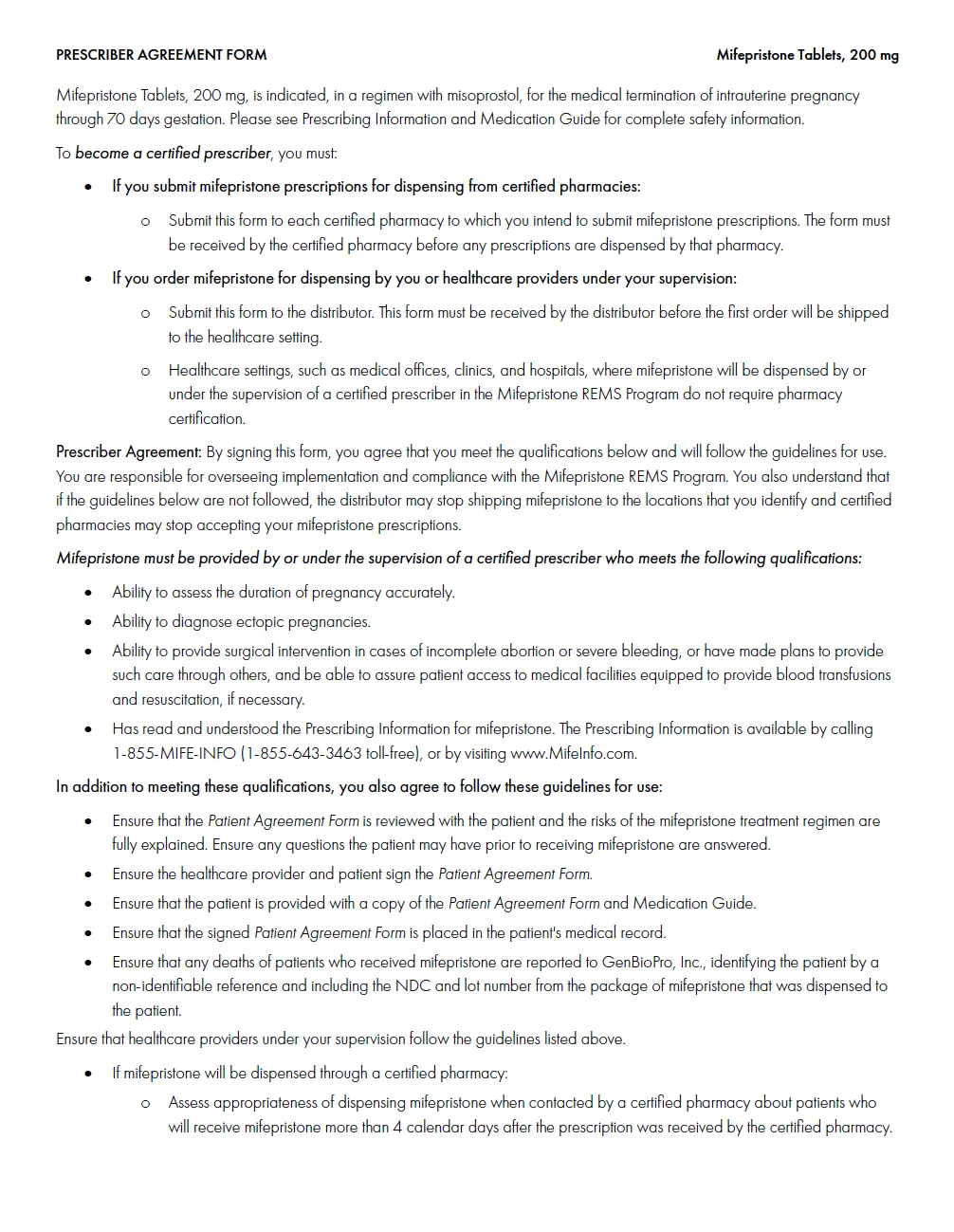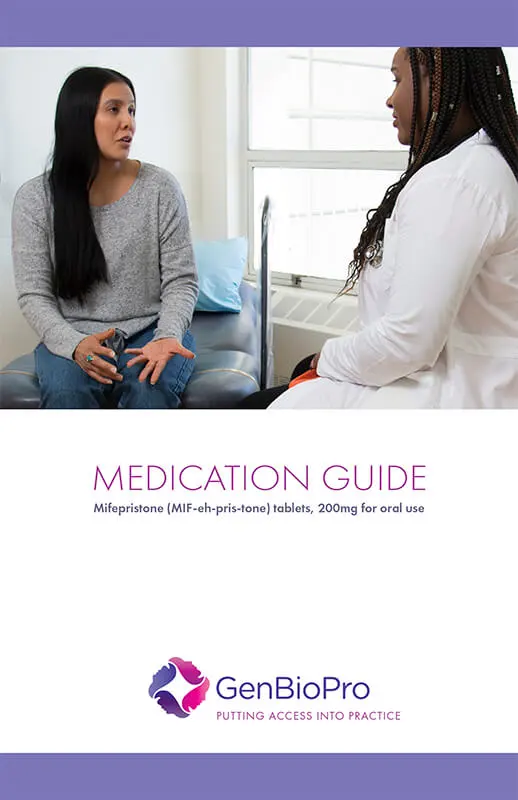Prescribing GenBioPro Generics for Medical Abortion

Start Prescribing GenBioPro Generic Mifepristone Tablets, 200 mg
To begin prescribing GenBioPro mifepristone tablets, 200 mg, to your patients, you must first become a certified GenBioPro prescriber. It’s quick and easy.
- Step 1: Download your Prescriber Agreement here.
- Step 2: Fill out the form as instructed and sign where indicated.
- Step 3: Submit the signed agreement to GenBioPro online, or by faxing it to 1-877-239-8036 or emailing to RxAgreements@genbiopro.com.
If you will dispense directly to patients, our authorized distributor will contact you to establish an account and approve you to begin ordering.
If you will send orders to a pharmacy for dispensing, please also send your completed agreement to the certified pharmacy of your choice. Your Agreement must be on file before a certified pharmacy can fill your order. Click here to see a list of available certified pharmacies.
That’s it. You’re ready to start prescribing GenBioPro mifepristone tablets, 200 mg.
Restricted Prescribing Parameters
Mifepristone is available only under an FDA-approved Risk Evaluation and Mitigation Strategy (REMS) program. The REMS program requires that all certified GenBioPro prescribers complete and sign our Prescriber Agreement, returning a copy to our distributor for dispensing or to the certified pharmacy of choice for pharmacy dispensing. Additionally, it requires that prescribers secure a signed Patient Agreement from each patient.
Detailed Requirements for Certified GenBioPro Prescribers:
All prescribers of generic mifepristone tablets, 200 mg, from GenBioPro must:
- Review and understand the full prescribing information.
- Be able to confirm that the pregnancy is within 70 days from the start of the patient’s last menstrual period and that it is uterine, rather than ectopic.
- Walk the patient through the Patient Agreement and Medication Guide and fully explain the medical abortion process and its risks.
- Sign and secure the patient’s signature on the Patient Agreement.
- Provide the patient with a copy of the Patient Agreement and Medication Guide.
- Retain the signed Patient Agreement.
- Prescribers who dispense in person must record the NDC and lot numbers from the prescribed package of generic mifepristone tablets, 200 mg, in the patient’s medical record.
- Provide or direct patients to facilities equipped for surgical intervention (including blood transfusion or resuscitation) in the event of an incomplete abortion or severe bleeding.
- Contact GenBioPro immediately to report any patient deaths that you become aware of, designating the patient by a non-identifiable reference. Prescribers dispensing must provide the NDC and lot numbers from the package of generic mifepristone tablets, 200 mg, or contact information for the certified pharmacy used to fill the prescription.
For more information, review the FDA-Approved Mifepristone REMS Program at REMS@FDA.

Use
Mifepristone is used in combination with misoprostol to carry out an early abortion. “Early” is defined as up to 70 days from the first day of your patient’s last menstrual period.
How to Prescribe and What to Expect
- Prescribe a 200 mg generic mifepristone tablet to your patient, to be administered orally.
- Prescribe 800 mcg misoprostol (four 200 mcg tablets) to be taken buccally 24-48 hours after ingestion of mifepristone. Tell the patient to place 2 tablets in each cheek pouch for 30 minutes and then swallow any remnants with liquid.
- Provide additional medicine or prescriptions to help manage common cramps or gastrointestinal symptoms.
- Most pregnancies will be expelled within 2-24 hours after the administration of the misoprostol.
- Follow up with your patient 7 to 14 days following the medical abortion to assess bleeding and confirm termination of pregnancy.
Preparing Patients for Side Effects
Download the Medication Guide.
Provide your patient with:
- Medicine or prescriptions for cramps, nausea, or diarrhea as desired.
- Instructions on what to do in the event of significant discomfort, excessive vaginal bleeding, or other significant adverse reactions.
- A phone number to call if the patient has questions.
- The name and phone number of the health care provider who will handle emergencies.
Contraindications
Administration of mifepristone and misoprostol for the termination of pregnancy is contraindicated in patients with any of the following conditions:
- Confirmed or suspected ectopic pregnancy. Mifepristone is not effective for terminating ectopic pregnancies.
- Chronic adrenal failure.
- Concurrent long-term corticosteriod therapy.
- Allergy to mifepristone, misoprostol, other prostaglandins, or medicines containing them, such as Cytotec or Arthrotec.
- Hemorrhagic disorders or concurrent anticoagulant therapy, which may increase the risk of heavy bleeding.
- Inherited prophyrias.
- Presence of an IUD (intrauterine device or system). It must be removed before the administration of mifepristone.
Warnings and Precautions
Heavy bleeding, cramping, and nausea are common side effects of the mifepristone / misoprostol regimen. The following are serious and sometimes fatal complications, requiring immediate medical attention:
- Infection and sepsis: a sustained fever of ≥100.4°F, severe abdominal pain, or pelvic tenderness may be indications of an infection.
- Uterine bleeding: prolonged heavy bleeding (soaking through two thick sanitary pads per hour for 2 consecutive hours) may be a sign of incomplete abortion or other complications.
Drug Interactions
Some drugs may reduce or increase the exposure to mifepristone:
- Presence of CYP3A4 inducers, including rifampin, dexamethasone, St. John’s Wort, and certain anticonvulsants such as phenytoin, phenobarbital, and carbamazine. These may induce mifepristone metabolism and impact the efficacy of the dose.
- Presence of CYP3A4 inhibitors, including ketoconazole, itraconazole, erythromycin, and grapefruit juice, which may inhibit mifepristone metabolism.
- Presence of CYP3A4 substrates with narrow therapeutic range.
Refer to the Important Safety Information below for further information.
Need More Information?
Contact us if you have more questions about medical abortion, becoming a certified GenBioPro prescriber, ordering product, or to request additional copies of the full prescribing information or other resources:
Online | 1-855-643-3463 | info@genbiopro.com

